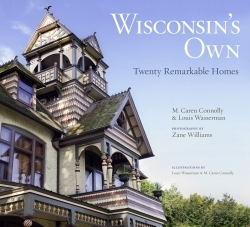Wisconsin's Own
Twenty Remarkable Homes
- 2010 INDIES Winner
- Gold, Home & Garden (Adult Nonfiction)
Architects M. Caren Connolly and Louis Wasserman, authors of Updating Classic America: Bungalows and several other illustrated books, teamed up with the Wisconsin Historical Society to choose twenty homes that represent the rich and varied history of Wisconsin architecture from 1854 to 1939. Each of these indeed remarkable homes is presented in detail with stunning color illustrations, which include Zane Williams’s new photography of each impeccably preserved site, historical photographs of the homes from the time of their first residents, maps, and exquisite full-color elevations and plans hand-drawn by Connolly and Wasserman. The drawings are so impressive—serving both as nuggets of information and tiny works of art—that one is grateful for and delighted by the appendix that describes the authors’ drawing process in full detail.
The images alone that grace Wisconsin’s Own are enough to keep this book placed prominently on the coffee table, but the illuminating, well-researched, and pleasantly narrative text will keep readers from simply flipping through it like a picture book. The book begins with the story of the Octagon House, designed and built in 1854 by John Richards as a promise to his East Coast–bred wife that he would build her the “finest and most modern house in the Wisconsin Territory.” The authors bring to life the couple’s move to the Midwest, the process of building the house, and the unique advantages of the octagonal floor plan, which was popularized for a short time during that period before largely dying out. Due to the careful specifics of the home’s interior, Mrs. Richards could bake twenty-four loaves of bread at once in the large Dutch oven. The innovative use of air flow throughout the house and at the top of the cupola (located in the center of the octagon plan) allowed for an advanced central heating and cooling system to respond to the disparate Wisconsin weather year-round. The level of detail provided about the house itself and the rich history of its building are captivating.
Each of the twenty homes featured in the book receives the same treatment, with some stories more tragic than others, and some architect-client relationships more controversial than others. And since the homes span nearly one hundred years of architectural history, many different styles, architectural icons (including Frank Lloyd Wright), and individual stories emerge. The innovation, beauty, hardship, missteps, and accomplishment inherent to these stories lend the book a great appeal to general readers, history and architecture buffs, and fans of Wisconsin lore. The quality of the production and the excellence of the artwork also elevate the book to the category of book-as-art-object: a beautiful addition to any curious reader’s library.
Reviewed by
Kara Mason
Disclosure: This article is not an endorsement, but a review. The publisher of this book provided free copies of the book and paid a small fee to have their book reviewed by a professional reviewer. Foreword Reviews and Clarion Reviews make no guarantee that the publisher will receive a positive review. Foreword Magazine, Inc. is disclosing this in accordance with the Federal Trade Commission’s 16 CFR, Part 255.

